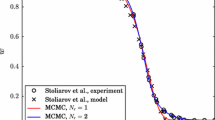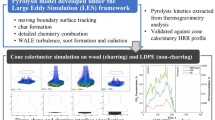Abstract
Pyrolysis models for burning solids in fire simulations are sensitive to the values of the activation energy, frequency factor, and reaction order that characterize the thermal decomposition of the solid to gaseous fuel, so direct measurement of these kinetic parameters is recommended, and simple methods are preferred. Three direct methods were evaluated with regard to the ability of their kinetic parameters to reproduce the thermal decomposition of five polymers measured by differential thermogravimetric analysis using the reaction order model. It was found that the two multiple heating rate methods produced identical, physically based kinetic parameters, while the peak property method produced non-physical kinetic parameters. However, all of these kinetic parameters in a single-step reaction order model gave reasonably good conversion histories for non-charring and moderately charring polymers. For a highly charring polymer, the conversion histories were poorly described without a multiple step reaction. The temperature at the maximum rate of conversion was found to be essentially independent of the reaction order, which decouples the frequency factor from the reaction order in the direct kinetic methods. Any of the direct methods are sufficiently accurate to obtain kinetic parameters for pyrolysis models because of the inherent spatial and temporal averaging of reaction rates at the burning surface of a thick solid and the uncertainty in the heat transfer mechanisms and thermo-physical parameters used in the models.











Similar content being viewed by others
References
Vyazovkin S, Burnham AK, Criado JM, Perez-Maqueda, Popescu C, Sbirrazzuoli N. ICTAC kinetics committee recommendations for performing kinetic computations on thermal analysis data. Thermochim Acta. 2011;520:1–19.
Vyazovkin S, Wight CA. Model-free and model-fitting approaches to kinetic analysis of isothermal and nonisothermal data. Thermochim Acta. 1999;340(341):53–68.
Flynn JH, Wall LA. General treatment of the thermogravimetry of polymers. J Res Natl Bureau Stand-A. Phys Chem. 1966;70A(6):487–523.
Galwey AK, Brown ME. Kinetic background to thermal analysis and calorimetry, in handbook of thermal analysis and calorimetry, Vol 1. Principles and practice. Brown ME ed. New York: Elsevier; 1998:147–224.
MacCallum JR. The interpretation and mechanistic significance of data derived from thermogravimetry. Br Polym J. 1979;11(3):120–2.
Staggs JEJ. A theoretical investigation into modeling thermal degradation of solids incorporating finite rate kinetics. Combust Sci Technol. 1997;123:1–6.
Lyon RE. Heat release kinetics. Fire Mater. 2000;24(4):179–86.
Stoliarov SI, Lyon RE. Thermo-kinetic model of burning. Technical note DOT/FAA/AR-TN08/17. May 2008; Federal Aviation Administration.
Stoliarov SI, Safronava N, Lyon RE. The effect of variation in polymer properties on the rate of burning. Fire Mater. 2009;33:257–71.
Stoliarov SI, Crowley S, Lyon RE, Linteris GT. Prediction of the burning rates of non-charring polymers. Combust Flame. 2009;156:1068–83.
Stoliarov SI, Crowley S, Walters RN, Lyon RE. Prediction of the burning rate of charring polymers. Combust Flame. 2010;157:2024–34.
McGrattan KB, Klein B, Hostikka S, Floyd J. Fire dynamics simulator (version 5) user’s guide. NIST special publication 1019-5. 2007; National Institute of Standards and Technology, Gaithersburg.
Linteris GT. Numerical simulations of polymer pyrolysis rate: effect of property variations. Fire Mater. 2011;35(7):463–80.
Lautenberger C, Fernando-Pello C. Generalized pyrolysis model for combustible solids. Fire Saf J. 2009;44(6):819–39.
Lyon RE, Safronava N, Oztekin E. A simple method for determining kinetic parameters for materials in fire models, 10th International symposium of the international association for fire safety science. June 19–24, 2011. College Park.
Schartel B, Weib A. Temperature inside burning polymer specimens: pyrolysis zone and shielding. Fire Mater. 2010;34(5):217–35.
Matala A, Lautenberger C, Hostika S. Generalized direct method for pyrolysis kinetic parameter estimation and comparison to existing methods. J Fire Sci. 2012;30(4):339–56.
Bal N. Uncertainty and complexity in pyrolysis modeling, PhD Thesis, University of Edinburgh, 2012.
Standard method for decomposition kinetics by thermogravimetry. ASTM E 1641. 2007. American Society for Testing & Materials (International). West Conshohocken.
Lyon RE, Safronava N, Stoliarov SI, The Role of Thermal Decomposition Kinetics in the Burning Behavior of Polymers. INTERFLAM 2010, July 5-7, 2010. U. Nottingham, UK.
Gorbachev VM. A solution of the exponential integral in the non-isothermal kinetics for linear heating. J Therm Anal. 1975;8(2):349–50.
Lyon RE. An integral method of nonisothermal kinetic analysis. Thermochim Acta. 1997;297:117–24.
Cai JM, Liu RH. Precision of integral methods for the determination of the kinetic parameters used in the kinetic analysis of solid-state reactions. J Therm Anal Calorim. 2008;91(1):275–8.
Starink MJ. The determination of activation energy from linear heating rate experiments: a comparison of the accuracy of isoconversion methods. Thermochim Acta. 2003;404:163–76.
Standard test method for Arrhenius kinetic constants for thermally unstable materials using differential scanning calorimetry and the Flynn/Wall/Ozawa method. ASTM E 698. 2011. American Society for Testing & Materials (International). West Conshohocken.
Friedman HL. Kinetics of thermal degradation of char-forming plastics from thermogravimetry applied to a phenolic plastic. J Polym Sci, Part C, Polym Symposia. 1964;6(1):183–95.
Friedman HL. New methods for evaluation kinetic parmameters from thermal analysis data. J Polym Sci: Polym Lett. 1969;7(1):41–6.
Ozawa T. Kinetic analysis of derivative curves in thermal analysis. J Therm Anal. 1970;2:301–24.
Ozawa T. A new method of analyzing thermogravimetric data. Bull Chem Soc Jpn. 1965;38(11):1881–6.
Flynn JH. Temperature dependence of the rate of reaction in thermal analysis. J Therm Anal. 1990;36:1573–9.
Kissinger HE. Variation of peak temperature with heating rate in differential thermal analysis. J Res Natl Bureau Stand. 1956;57(4):217–21.
Kissinger HE. Reaction kinetics in differential thermal analysis. Anal Chem. 1957;29(11):1702–6.
Koga N, Sestak J. Kinetic compensation effect as a mathematical consequence of the exponential rate constant. Thermochim Acta. 1991;182:201–8.
Gao Z, Kaneko T, Hou D, Nakada M. Kinetics of thermal degradation of poly(methyl-methacrylate) studied with the assistance of the fractional conversion at the maximum rate. Polym Degrad Stab. 2004;84:399–403.
Coats AW, Redfern JP. Kinetic parameters from thermogravimetric data. Nature. 1964;201(4914):68–9.
Gao X, Chen D, Dolimore D. The correlation between the value of α at the maximum reaction rate and the reaction mechanism: a theoretical study. Thermochim Acta. 1993;223:75–82.
Kim S, Park JK. Characterization of thermal reaction by peak temperature and height of DTG curves. Thermochmica Acta. 1995;264:137–56.
Kim S, Jang ES, Shin DH, Lee KH. Using peak properties of DTG curve to estimate the kinetic parameters of the pyrolysis reaction: application to high density polyethylene. Polym Degrad Stab. 2004;85:799–805.
Eom Y, Kim S, Kim SS, Chung SH. Application of peak property method for estimating apparent kinetic parameters of cellulose pyrolysis reactions. J Ind Eng Chem. 2006;12(6):846–52.
Standard test method for thermal stability by thermogravimetry. ASTM E 2550. 2008. American Society for Testing & Materials (International) West Conshohocken.
Lyon RE, Safronava N, Senese J, Stoliarov SI. Thermokinetic model of sample response in nonisothermal analysis. Thermochim Acta. 2012;54:82–9.
Standard practice for temperature calibration of differential scanning calorimeters and differential thermal analyzers. 2008. ASTM E-967. American Society for Testing & Materials (International). West Conshohocken.
Lyon RE, Walters RN, Stoliarov SI. Thermal analysis of flammability. J Therm Anal Calorim. 2007;89(2):441–8.
Standard test method for determining flammability characteristics of plastics and other solid materials using microscale combustion calorimetry. ASTM D 7309. 2011. American Society for Testing and Materials (International). West Conshohocken.
Acknowledgments
Certain commercial equipment, instruments, materials, and companies are identified in this paper in order to adequately specify the experimental procedure. This in no way implies endorsement or recommendation by the Federal Aviation Administration.
Author information
Authors and Affiliations
Corresponding author
Rights and permissions
About this article
Cite this article
Lyon, R.E., Safronava, N. A comparison of direct methods to determine n-th order kinetic parameters of solid thermal decomposition for use in fire models. J Therm Anal Calorim 114, 213–227 (2013). https://doi.org/10.1007/s10973-012-2916-z
Received:
Accepted:
Published:
Issue Date:
DOI: https://doi.org/10.1007/s10973-012-2916-z




